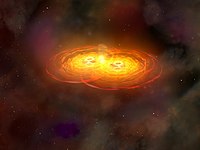
Photo from wikipedia
In recent past, Hawking temperature has been modified for the validity of thermodynamical laws at the event horizon in general relativity context. This lead to the introduction of modified Hawking… Click to show full abstract
In recent past, Hawking temperature has been modified for the validity of thermodynamical laws at the event horizon in general relativity context. This lead to the introduction of modified Hawking temperature and it has been found that the modified Hawking temperature is more realistic on the event horizon. With this motivation, here we investigate the thermodynamical consistency of scalar-tensor gravity based models by examining the validity of the generalized second law of thermodynamics (GSLT) and thermodynamical equilibrium (TE) at the event horizon. In order to attain our goal, we consider a spatially flat Friedman–Robertson–Walker Universe filled with ordinary matter and the boundary of the Universe bounded by the event horizon that is in thermal equilibrium with modified Hawking temperature. Next, we calculate the general expressions for the GSLT and TE using modified Hawking temperature in the context of the more general action of scalar-tensor gravity where there is a non-minimally coupling between the scalar field and matter Lagrangian (as the chameleon field). From the general expression of GSLT, we find that the null energy condition must hold for a viable scalar-tensor model of the Universe dominated by a perfect fluid. Furthermore, in order to better understand these complicated general expressions of GSLT and TE, we explore the validity of the GSLT and TE for two viable models of scalar-tensor gravity namely Brans–Dicke gravity with a self-interacting potential and Chameleon gravity at the event horizon using special cosmological solutions. Finally, some graphical representation of the GSLT and TE have been presented. From the graphical analysis, we found that the power-law forms of the scale factor and scalar field is much favourable for the study of universal thermodynamics as compared to other choices of the scalar field and the analytic function.
Journal Title: General Relativity and Gravitation
Year Published: 2018
Link to full text (if available)
Share on Social Media: Sign Up to like & get
recommendations!